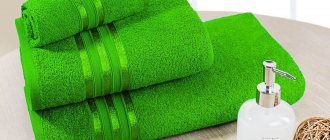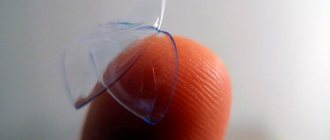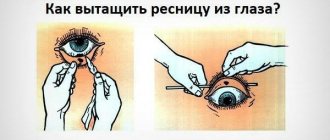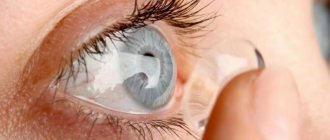How to get it
How to pull out by hand
It is important to know how to put on colored or treatment lenses for the first time. The simplest and most accessible method for removing a lens from your eye if it has rolled onto the white of the eye is to use your fingers
Algorithm of actions:
- Look up, at the same time lightly press the lens with your index finger and pull it down.
- Pull the lower eyelid towards the center of the product, grab the lens with two fingers.
- Place in a container filled with solution. Use drops.
Using drops
Using a storage and rinsing solution and simple drops, the lens can be easily “washed out of the eye.” Working technology:
- Lift the eyelid behind which the product is located using the fingers of one hand.
- With the other hand, drop as much of the solution as possible onto the cornea so that it mechanically slides to the near corner of the eye.
- Remove the product by hand and put it in a container.
Water
The method is suitable for removal in case of complications such as increased dryness and irritation. Simultaneously with the removal of the product, the entire conjunctiva is washed. Algorithm:
- Fill a container with warm boiled water so that the height from the surface is at least 5 cm.
- Lower the water so that the desired eye is completely immersed in water, blink several times.
This method is not recommended for children and hypersensitivity - it can cause discomfort and discomfort. Find out how to put on daily lenses correctly by following this link.
Special tweezers
Sometimes a special plastic tweezers are included with the storage container. The sequence of action is similar to using fingers - pull back the eyelid and remove it from the cornea using tweezers. A mirror is required to avoid damaging the sensitive tissues of the eye. Find out what to do if your eyes get dry while wearing lenses.
Tweezers are convenient to use for removal if it is not possible to thoroughly wash your hands before the procedure.
How to remove the lens correctly
Lenses are removed and put on only after hands have been thoroughly washed. If you neglect this simple rule, you can get an infection. It is not enough to use a damp cloth to wipe your hands. It is not recommended to use alcohol-containing antibacterial gel for these purposes.
Hands are washed under running water using antibacterial soap. It is best if it is liquid, because solid leaves a residue on the fingertips. Dry your hands with a cloth or paper towel. A terry towel is not suitable for these purposes, because the lint sticks to your fingers, causing quite unpleasant sensations when removing lenses.
You need to sit at the table, leaning on its surface. A mirror, tweezers, and a lens container filled with fresh solution should be located nearby. The light should be bright, but not in your eyes.
Step-by-step instructions for removing lenses from your eyes:
1. The lower eyelid is pulled down with the middle finger and fixed in this position. 2
The index finger of the other hand gently touches the surface of the lens. In this case, you should not make sudden movements
The gaze should be directed straight. If the cornea is dry and the film cannot be moved, moisturizing drops are applied to the eye. 3. Press the lower part of the lens with your finger and gently move it towards the eyelid. As soon as its edge is below the pupil, it is pinched with the thumb and forefinger and removed. Those with long nails can hook this optical accessory without moving it below the pupil. But it is better not to use this method, because you can accidentally tear it. 4. The lens is placed in the center of the palm and cleaned with a special solution. After this, it is placed in a container with liquid, completely immersed in the composition, using tweezers with rubber tips.
Features of removing hard lenses
Rigid optical accessories can be removed in three ways:
- Method number 1. The film should fall out of the eye on its own. To do this, tilt your head over a clean surface. Use your index finger to press on the middle of the upper eyelid. With the same finger of the other hand, squeeze the middle of the lower eyelid. After this, the eyelids are moved towards each other. As a result of this action, an “air cushion” is formed between the film and the eye shell, due to which the lens falls out on its own.
- Method number 2. The head is tilted over a clean surface. Using your index finger, pull the outer corner of the eye towards the ear. As the eyelids begin to touch, the film will come out of the eye.
- Method No. 3. They hold their head straight and roll their eyes. The index finger is placed on the surface of the lens and moved down until it touches the sclera. It is carefully lifted with the thumb and forefinger and removed.
Using the suction cup
For those who are removing lenses from their eyes for the first time, it is recommended to use a suction cup. It is a special device that removes an optical accessory using suction.
The advantages of the suction cup are as follows:
- safety - no need to touch your eyes with your finger,
- convenience - the product is firmly attached to the device and does not “ride”,
- precision - the puller is suctioned exactly in a specific place,
- accuracy - the film does not deform.
Before use, the suction cup is sterilized. In the future it is used as follows:
- moisturizing drops are applied to the eyes,
- take the suction cup in one hand, and open the eyelids with the index finger and thumb of the other hand,
- press the bulb and apply the suction end to the eye at an angle of 90 degrees, after which the bulb is released,
- when the air comes out, the device is pulled towards itself, while the film is on the suction cup.
Why does the lens stick to my finger?
Mostly beginners face the problem of putting on and taking off lenses. The speed of donning comes with experience in using contact optics.
Lots of liquid
A few drops are enough to put on the eye. The finger itself should remain dry. If you pour more multifunctional solution, the CL will stick to your finger and will be difficult to put on.
Wet hands
Before each removal or use, they are washed with antibacterial soap.
It’s not for nothing that ophthalmologists advise wiping your hands dry. Therefore, the product will stick to wet ones. Experienced users also wear with wet hands, speed comes with long use. If you can’t put it on, place the lens in the liquid and turn it inside out 2-3 times. It will be well saturated with the product and the problem of sticking to the fingertip will be solved.
Material
The behavior of an optical vision product depends on the material from which it is made. Hydrogel products contain enough moisture, they are soft and thin. Such optics can turn inside out and remain on your finger when you try to put them on.
Products containing silicone are easier to handle. It is ideal for beginners. They are denser, therefore more obedient and easy to put on.
Technique
The CL remains on the finger because it does not have time to stick to the eye.
When a foreign object approaches, the user blinks frequently, so the lens does not have time to catch on the protein shell. This problem can be solved - the main thing is the correct technique of putting on the products. You need to hold your eyelids. It will take more than a month to get used to the process and stop blinking.
Marriage
Manufacturing defects are a rare cause. If you put it on correctly, in compliance with all the listed rules, you should contact the salon where you purchased the optics. The consultant can solve the problem or replace the product.
Turned inside out
Even experienced CL users encounter this problem. If the product is turned inside out, it will remain on the finger and will not stick to the eye. More often the reason is the material; hydrogel products tend to turn out.
Mishandling
Products remain on the finger because they are not handled correctly. Before purchasing contact vision correction products, visit an ophthalmologist. There are courses on wearing and handling lenses.
Why might the lens not be removed?
There are many reasons that cause problems with lens removal.
Everyone has a desire to save money, but saving on health often results in increased costs for its restoration. Most problems associated with lenses appear due to the unwillingness to go to an ophthalmologist.
Based on many years of experience in using lenses, a variety of reasons have been classified that contribute to the fact that the lens is not removed:
- The period of adaptation of the eye to the lens. Wearing lenses every day requires developing the skills to remove and put on lenses, restraining the desire to rub the eye, and ignoring the feeling that a foreign object has stuck to the eye. In the ophthalmologist's office, the client undergoes detailed instructions with a clear example of the use of lenses; to master the skill, you can visit the doctor's office again.
- Individual incredible dryness of the eye. It is characterized by insufficient production of natural eye secretions due to hereditary reasons, aging of the body, and the proximity of menopause. Occurs due to exposure to tobacco smoke or other types of smoke, prolonged presence at the monitor, exposure to air conditioning, batteries.
- Offset lens placement. A correctly positioned lens is located in the center of the eye; frequent blinking, or rubbing the eye with your hands, displaces the lens, making it difficult to remove it from the surface. Once the lens is in the correct position or moved to the corner of the eye, removal is not difficult.
- Wet hands. Lack of time means that wet fingertips sliding over the lens are unable to remove it due to lack of adhesion to the surface. Wait or dry your hands.
- Missing the optimal lens wear period. Removing the lens after missing the deadline leads to a negative effect on the eye due to the accumulation of deposits on the lens. Recommendations from an ophthalmologist and instructions for wearing certain contact lenses are the key to eye health.
- Lack of care for reusable lenses. By forgetting to put them in the enzyme cleaner, you risk causing the lens to stick to your eye. The best way to solve this problem is to switch to disposable lenses.
- Sleeping in contact lenses that are not intended for this purpose. In the morning, eyes with red swollen eyelids, with a stuck lens, evoke only sympathy. Sleep in lenses that allow you to sleep without taking them off; these are silicone hydrogel contact lenses that are highly permeable to oxygen.
- Follow-up visit to the ophthalmologist. The doctor will be able to identify early signs of diseases of the visual system. Lens sticking is associated with incorrectly selected base lens curvature.
Many people who have poor vision prefer contact lenses instead of glasses. In this case, in order to avoid problems with wearing them, the products must be selected correctly.
Only an ophthalmologist deals with this.
The selection procedure itself includes the following steps:
— The curvature of the cornea of the eyes is determined. For this purpose, special automatic devices are used.
— Determination of the degree of hydration of the cornea of the eye.
— Biomicroscopy — Eye examination using a slit lamp.
— Selection of Lenses, fitting and assessment of lens fit, determination of its mobility.
— Extracting the Prescription.
Your vision is checked regularly, at least once a year. If you experience problems with vision while wearing a GKB, you should consult a doctor. You need to understand that if you are prescribed glasses, you cannot buy contact lenses using this prescription.
With incorrectly selected soft contact lenses, a feeling of discomfort may occur.
The most important parameters are the mobility of the product in mind and the correct centering of the lens.
To eliminate inconveniences, you first need to understand the reasons for their occurrence.
Quite often, people who use lenses complain that the lens moves out of the eye.
There may be several reasons for this:
— Lenses incorrectly installed (on the contrary, turned inside out)
— The product does not fit tightly to the cornea of the eye;
— The person blinks frequently;
— Slozovidilennya Increased;
— Choose the wrong size lenses.
In some cases, the lens comes off due to improper application to the eye. In this case, you should remove the product and check the condition of the lens to see if it has turned in the opposite direction.
Possibly due to a lack of manufacturing or a defect, one of the lenses is an incorrect size other than stated, or an incorrect shape. In this case, the lens also slides off the eye. If the GKB from a particular company previously fit and “fit” perfectly, but problems arise with new lenses from the same manufacturer, then most likely this is a defect. The lens simply needs to be replaced.
Dependence on the manufacturer's brand also plays a role. Contact lenses from one manufacturer may fit differently than products from another manufacturer. In this regard, you should consult your doctor about companies that produce lenses.
With constant wearing, you will already decide which products from companies are suitable for you.
Many manufacturing companies conduct seminars on their products. They describe the products and provide detailed recommendations for their selection. Therefore, problems of switching to a GKB from another manufacturer also occur due to differences in design and size.
The lens design itself includes:
— Thickness of the product;
— Diameter;
— Base radius;
— Shape of surfaces.
Why do lenses move?
The reason for this may be the following: the lens is made too mobile through a large radius of curvature, the center of its placement shifts. In this case, you should change soft contact lenses to products with a smaller radius.
A possible problem of discomfort may be a cold, inflammation of the eyes and eyelids. During this period, tear production increases, which does not allow the lens to fit tightly on the eye. In this case, you need to stop wearing lenses for a while and switch to glasses.
The reason that the lenses move out may be due to their damage. As noted, when visiting a swimming pool, chlorine vapors can have a negative effect on products, worsening their properties. A long stay in a smoky room has the same effect.
Very rarely, but sometimes there are still cases when lenses cannot be selected at all.
What to do if the lens falls off your eye?
You can carefully pull the unruly lens out of the eye, rinse it well in the solution, and check whether it is returned correctly. Then try to put it back in place again. In this case, you should definitely wash your hands before the operation.
Sometimes, in order to return the lens to the eye, you can perform the following actions: blink, move the pupil left and right or up and down. If this does not help, gently move the lens with your finger until it is centered.
A guarantee of good service of the GKB is careful and constant care for them. Then there will be no problems with them slipping or causing other inconveniences.
Store lenses in a special container, in lens liquid. The solution in the container should be changed daily. Otherwise, the lenses may dry out and will not adhere well to the eye.
The lenses should be washed in a fresh solution to remove dirt and tear secretions from the eyes. And once every three months the container must be disinfected.
It is not recommended to wear lenses during colds. In this case, they can provoke further development of the infection.
In the diagnostic and treatment center “Optics Plus”, at Vinnitsa, st. 600th Anniversary, 4 ophthalmologist will provide full consultation on the selection and rules for using lenses. We are always glad to see you!
Can a foreign body get stuck in the eye and stay there?
The first thing you need to do when you find yourself in such a situation is to calm down. You can be absolutely sure that nothing will fall into the eye socket.
Important! The nature of the human eye is very wise: over time, our eye, like the ocean, takes out all kinds of garbage and is capable of self-cleaning. So sooner or later you will extract it
Everyone knows from the school anatomy course that the eyeball is securely attached to the orbit; it is surrounded by the superior, inferior, oblique, as well as internal and external muscles, thanks to which it moves. The muscles are attached directly to the eyeball and are securely fixed by fibrous connective tissues, which will not allow optical devices to penetrate into the depths. Therefore, the lens can only be found on the convex part - the cornea.
How to remove a lens from under the upper eyelid: 4 ways to remove the optics
Having made sure that the lens is difficult to remove due to dry mucous membranes, we make attempts to remove it.
- First, you need to drip moisturizing drops into your eye several times and carefully move your eyeball left and right, up and down, and also in a circular motion. A large amount of liquid will help return the lens to its original place and remove the product from the eye.
- Method two. After the eye is dripped, lightly grab the skin of the upper eyelid of the closed eye at the point of greatest recess into the eye socket with the thumb and forefinger, and make slow, gentle movements with your fingertips along the eyeball from top to bottom. Open your eyes and blink frequently. Repeat the procedure several times.
- If this does not help, prepare a mirror and good lighting that will help you see where exactly the culprit of your troubles is “sitting”. Tilt your head as high as possible so that your chin is horizontal. Lift the eyelid by the upper eyelashes and try to see the location of the lens. (For best results, apply moisturizing drops and continue to blink frequently).
If you can’t move it, try picking up its edge with special tweezers or a clean finger (but this advice is applicable if you are sure that you are absolutely calm, sober and the vision of the other eye allows you to see what is happening). A misaligned lens can usually be easily removed in the usual manner. After this, it is better to drip any available anti-inflammatory eye drops for preventive purposes.
Photo 2. A woman carefully removes a contact lens from her eye using her index finger and thumb.
- And the last, most extreme way. Prepare a small, deep, clean bowl with chilled boiled water (one and a half glasses is enough). Place it on the table and lower your face so that your eye is immersed in the water.
Relax and imagine that you are swimming in the sea or lake (after all, it’s not so scary when splashes get into your eyes, or we look underwater, diving and swimming). Open and close your eyes in the water, blink frequently, and you can slightly move your upper eyelid with your index finger. The lens can easily slip off.
The only disadvantage of the method is not to throw out the water with the child, that is, to be able to fish the optics out of the water. If you are unable to catch it with your hands, use a strainer and carefully pass the liquid through it. Place the found lens in the solution, and rinse your eyes with running water or chamomile decoction.
Why did the eye lens break and what should you do if this happens?
Modern content lenses are made from durable and elastic hydrogel polymers. But this does not mean that they have high wear resistance.
One careless action is enough and the lens will break in your hands, or, even worse, right on the eyeball.
Why is this happening? How to remove fragments of an ophthalmic product from under the eyelid? How to avoid common mistakes? Read more about this in this article.
Main reasons
Ophthalmologists identify five main causes of contact lens rupture:
- Low quality optics – low quality lenses are often made from cheaper and denser polymer. It not only has low oxygen permeability, which is bad for the mucous membrane of the eyeball, but also dries faster than its higher quality counterparts. The worse the lens is moistened, the higher the likelihood that microcracks will appear on its surface.
- Neglect of operating rules . Storage outside the solution, errors made during the process of putting on and taking off - all this renders the lenses unusable.
- Insufficient hydration – drying out of the lens on the eye often leads to its rupture. People at risk include people who wear lenses for more than eight hours a day and those who work in rooms with dry air.
- Worn after the expiration date - over time, the polymer becomes less plastic, and, accordingly, more fragile and prone to damage.
- Nails that are too long – Pointed and too long nail plates can not only damage the contact lens, but also injure the eye.
If you don’t want to give up an extravagant manicure in favor of wearing lenses, use a special suction stick or silicone tweezers to put them on and take them off.
What to do if it remains on the eyeball?
You can determine that the lens has torn directly on the eyeball by the following signs:
- feeling of “sand” or “mote”;
- a veil before the eyes;
- discomfort when rotating the eyeball.
Fragments of a torn lens can damage the mucous membrane and cause inflammation. To prevent this, timely peace measures must be taken.
- Do not panic. Do not rub your eyes, do not try to get your fingers under your eyelids.
- Take a mirror, ideally if it has a magnifying effect.
- Prepare the necessary tools and products: moisturizing drops, lens solution, tweezers or a suction cup.
In some cases, you will not be able to remove pieces of the lens on your own and will have to contact an ophthalmologist. The doctor will help you get rid of the problem.
How to get it out from under the upper eyelid?
You can remove the rolled-up lens from under the upper eyelid as follows:
- Apply moisturizing drops. The liquid will “lubricate” the lens, which will help return it to its original place and remove it from the eye.
- Close your eyelids and rotate your eyeballs, and then move them up and down, left and right.
- Massage your eyelid. After the eye is moistened, lift the eyelid by lightly pressing on it with the tip of your finger at the point where it is deepest in the eye socket. Make slow, gentle movements with your finger from top to bottom, straightening the lens onto the pupil. Blink well and repeat the procedure again.
- If you can’t move the lens, lift your eyelid and try to pick it up with your thumb and forefinger. It is important to keep your hands clean. You can also use special tweezers.
To avoid negative consequences, after removing the lens, you need to drop special moisturizing and anti-inflammatory drops into the eye.
How to get it out from under the bottom one?
The lower eyelid is less mobile than the upper eyelid and it will be much easier to remove a stuck lens from under it:
- Sit in front of a mirror and provide yourself with good lighting.
- Pull back your lower eyelid and evaluate how deep the lens goes. Blink vigorously to move the lens toward the surface. If this does not help, drop moisturizing drops into your eyes, close your eyelids and massage thoroughly towards the tear duct.
- Grab the edge of the lens with tweezers and gently pull it up. Do not make sudden movements - this can cause the lens to rupture even more.
What to do if it bursts and a piece remains and it is not visible?
It also happens that a piece of the damaged lens remains on the surface of the eye and cannot be detected, much less removed. In this case, you can try the following:
- Moisten your eyes generously with drops.
- Tilt your head up, pull back your upper and lower eyelids.
- Actively rotate your eyeballs - this will allow a piece of polymer to come to the surface, after which you can easily remove it.
Can it get lost on the eyeball?
To begin with, it is worth saying that the eyeball is surrounded by the upper, lower, and oblique muscles. It is securely fixed in the eye socket by fibrous connective tissues, which do not allow contact lenses to penetrate deeper. The optical device may turn up or roll behind the upper or lower eyelid, but it will not disappear from the cornea.
Is it possible to dress and wear something that is damaged or slightly torn?
Ophthalmologists categorically do not recommend wearing a damaged contact lens, even if there is only a small scratch on it or a small area has been torn off from the edge of the product. This can lead to the formation of microtraumas on the cornea.
If a contact lens breaks on your eye, it is better to seek help from an ophthalmologist in the next two days. The doctor will be able to examine the eye and, if necessary, remove any remaining polymer from it.
Prevention: how to put it on and prevent rupture?
To minimize the risk of lens rupture, follow these simple rules:
- Use a suction cup or tweezers - most often these can be found in a lens care kit. This tip is especially relevant if you have long and sharp nails.
- Make sure that the lens is not turned inside out - you can understand this by placing the lens on the pad of your finger and looking at it from the side. The product will have the shape of a “plate” with edges curved outward.
- Wear lenses with an appropriate radius of curvature. Changes in this direction to a smaller or larger direction can lead to the lens falling out or damage to the cornea.
- Buy contact lenses and care products only from trusted sellers and brands. If you have not had experience wearing lenses before, ask an ophthalmologist for advice.
- If the lens accidentally dries out in the container, soak it in the solution. Do not pull on the glued edges. After it has soaked, carefully inspect it for creases and tears.
- Do not wear lenses for longer than the prescribed period, and do not violate the wearing regime. You should not leave lenses in your eyes for longer than 12 hours.
- Use only professional care products for ophthalmic products. Do not try to make lens solution yourself - do not put your eyes at risk.
As you can see, following the operating rules in most cases helps to avoid rupture of the contact lens on the eyeball. But if this does happen, don’t panic. In most cases, the problem is easy to solve on your own.
Source: //oko-guru.com/linzy/uhod/pravila-noshenija/kak-dostat-esli-porvalas-v-glazu.html
Preventive actions
To avoid any difficulties during the use of contact lenses, it is enough to follow the recommendations of specialists who will help to avoid dry eyes, the introduction of bacteria, or difficulties with removal:
- Do not touch the “clear eyes” with dirty hands. Remember that they are home to millions of bacteria and pathogens. Wet wipes do not work well as a “cleaner”, so use liquid detergents
- It is not recommended to use alcohol-based disinfecting solutions; they can cause irritation or burn the mucous membrane,
- Moisten your eyes periodically with special drops. This point is especially relevant for people who spend a lot of time in front of a computer monitor.
- Hands should not only be washed, but also thoroughly dried. It is better to leave terry products for the bathroom, as they leave microscopic lint on your fingers, which can get into your eyes.
- The antiseptic solution for storing lenses must be renewed every day,
- Before heading to the store, visit an eye doctor. He will teach you how to use and wear the vision correction device,
- Strictly adhere to the duration of use, always remove them at night,
- Give up cigarettes and, if possible, stay away from places where people smoke. Tobacco smoke negatively affects the condition of the mucous membrane,
- Replace lens storage containers every three months and wash them daily. Make sure that water does not accumulate in them, this can provoke the introduction of a viral or infectious pathology,
- Do not swim or sleep with contact lenses on, even if the manufacturer claims that this will not harm your vision.
- Stay hydrated and drink plenty of fluids throughout the day to keep your eyes hydrated.
- Lead an active lifestyle, eat right, get enough sleep,
- Visit an ophthalmologist for a routine examination at least once a year, this will help to identify deviations in visual function at an early stage and begin therapy,
- If you experience symptoms such as redness of the eyes or a feeling of the presence of a foreign object in them, contact the clinic immediately.
Girls are advised to apply makeup after the lenses are inserted. Do not use saliva to moisten your optics; it contains an incredible amount of microbes that can happily migrate to your eyes.
| Before dripping any solution, carefully read the instructions for use. Do not carry optical plates purchased without a prescription. They can damage the mucous membrane, cause infection and even lead to loss of vision. |
We remove the speck from the eye. Emergency help
Table. What to do after a speck gets into your eye.
| Steps, photo | Description of actions |
| Step 1 | Make your eyes water. Watery eyes may begin on their own after being hit by a foreign object, but if this does not happen, try blinking quickly. You can't rub your eyes! |
| Step 2 | If tears don't help, try to determine where exactly the speck is located. Examine the wide-open eye, moving it in different directions. If necessary, you can pull back the upper and lower eyelids and look underneath them. In this case, outside help may be required. |
| Step 3 | Pull the upper eyelid over the lower eyelid, then rotate the eye. The eyelashes of the lower eyelid can remove the foreign object. You may need to repeat this procedure several times. If there is no result, try another method. |
| Step 4 | Use a cotton swab soaked in clean water to remove the debris. Obviously, you must first determine where it (the speck) is located. Under no circumstances should you remove a foreign object located on the cornea using this method! |
| Step 5 | Rinse your eye with room temperature water. If there is no one to help, use a pipette to rinse. |
| Step 6 | You can also use a saline solution or artificial tear eye drops for rinsing. If this method does not produce results, all that remains is to consult a doctor. |
In what cases is medical assistance required:
- the speck could not be eliminated by any of the methods;
- after removal you feel discomfort, pain, and redness;
- a foreign object is inside the eye;
- vision problems appeared.
First aid
Preventing lens problems
Preventative measures will help avoid unpleasant situations with lenses.
People who prefer to use lenses should take proper care of them, otherwise they risk acquiring certain eye diseases. Preventive measures are not simple, but must be followed:
- Do not touch your eyes with hands that have not been washed with soap.
- Apply moisturizing drops throughout the day until you feel discomfort.
- Never wet your lenses with saliva, as this can lead to protein contamination and infection.
- Always keep spare lenses or a container of solution ready.
- Containers with the solution are changed every 3 months.
- Carefully follow the instructions for cleaning and disinfecting the type of lenses you choose.
- Wear lenses as directed by your ophthalmologist.
- When performing hygiene procedures related to your face, remove your lenses.
- Keep an eye on your water balance.
- Wearing lenses is a reason to try to quit smoking; smokers have problems with dry eyes when wearing lenses.
- Visit your ophthalmologist regularly.
So, the problem with removing eye lenses is quite common. By following simple recommendations, in most cases, you can remove it yourself. If this cannot be done, you should contact an ophthalmologist.
In the video you will find useful tips regarding wearing and removing contact lenses:
What to do if the lens does not come off?
How to remove a contact lens from your eye? Should I go straight to the clinic or get rid of the problem on my own? By following simple tips, the procedure can be carried out at home. But if they do not help, then immediately go to the ophthalmologist.
Depending on the type of optics, there are nuances when removing. Remember that it differs in thickness, size and structure. However, regardless of the type of lens, stick to one rule - no panic! First of all, calm down, nervous movements will only make the situation worse.
The majority of people, if they cannot immediately remove the plate, begin to scratch their eyes, touching the cornea with their hands again and again. This can lead to irritation and the development of inflammatory processes. If the mucous membrane turns red, pain and burning appear, close your eyelids for a couple of minutes, take a breath, then try again.
Soft contact lenses
This type of optics is more often used because it is comfortable and practically not felt, and the risk of injury to the cornea is minimized. What to do if a hydrogel lens gets stuck in your eye? Ophthalmologists give the following advice:
Wash and dry your hands before putting on and taking off. Wet fingers will slide across the surface of the record, making it impossible to grasp and move. Never touch the lens with dirty hands, especially if it gets stuck! Since contact with the mucous membrane is “protracted,” bacteria can easily penetrate the cornea and provoke the development of pathologies; When removing optics, choose a flat and smooth surface as they may fall out of the eye.
If you do not pay attention to this, you will continue to make attempts to remove it; First, the lens must be found in the eye. She may roll behind him or move to the side
Touching the cornea will not produce results, since there are no optics there. In this case, there are two ways: close the eyelid and return the “fugitive” to its place or try to pull it to the corner of the eye to remove it; If the lens categorically “refuses” to come out, then try using special “artificial tear” drops. They moisturize the cornea well and greatly facilitate the removal process. The technique is highly effective and helps in 80% of cases; If you can’t remove the lens on your own, call your family or friends for help. Often it slips under the upper eyelid, then it will not be possible to get it out without outside help. Tilt your head back, lower your gaze so that the assistant can examine the optics and remove it with smooth movements.
| If the eye becomes red, sharp pain occurs, or bleeding occurs within a few minutes, call a doctor immediately. Remember that all independent manipulations to remove a stuck plate can lead to injury to the cornea. |
Hard contact lenses
They are characterized by increased density, so if used incorrectly there is a risk of damage to the mucous membrane. At the same time, they have good throughput and attract less pollution.
If the hard lens cannot be removed, try the following manipulations:
- At the beginning of the procedure, use the same recommendations as when removing soft lenses. Wash and dry your hands;
- If the first attempt fails, rest for a couple of minutes and calm down;
- Determine the location of the optics, move your eyes in different directions. Ask relatives for help;
- Specialized stores sell unique devices for removing lenses - suction cups. Before purchasing them, ask your doctor to teach you how to use them. First of all, rinse the device thoroughly, use your fingers to spread your eyelids, secure them to the plate and pull them towards you. Before manipulation, make sure that the optic is in the center of the eye. The mucous membrane should not be touched with suction cups. At the same time, the puller has a number of advantages: comfort, reliability, accuracy, accuracy;
- If none of the above methods brings results, and the eye begins to turn red, go to an appointment with an ophthalmologist.
| No need to vigorously rub your eyelids or scratch your eyes! Remember that hard lenses can easily damage the mucous membrane due to their dense structure and lead to hemorrhage. |
What to do if the lens does not come off
Lenses can be soft or hard. Each type has its own rules that must be used when removing them.
All this is important in order to avoid infection. When the lens gets stuck, the person has to touch the eyeball with their fingers
It may not work the first time, and the more attempts, the greater the likelihood that an infection will occur. This is why you should not touch anything else after washing your hands.
The second common point is calm
This is also very important, because panic does not lead to anything good. You need to know that the lens will not go anywhere and will never fall behind the eyeball
The eye is designed in such a way that this is impossible. You also need to understand that if nothing works out on your own, you can still leave them for a while until you have the opportunity to see a doctor. An extra couple of hours won't do any harm. It’s worse if an eye injury occurs when you try on your own.
Methods for removing soft lenses
To remove soft optics from your eyes, you need to take the following steps:
First of all, you need to discover where the optics are located. Usually problems with removal occur when it has moved to the side. To find it, you need to close your eyes and move your eyeballs. If you can’t feel the lens, you need to press your eyelids a little with your fingers and feel. If it is not detected, it may have fallen out unnoticed - this also happens. When the optics are found, you need to put special drops on it to moisten it. To do this, pull back the eyelid with two fingers, insert a dropper over the lens and drip. As soon as the eye becomes moist, it should unstick from its location and move freely under the eyelid. Then it can be removed as usual. Blink several times, trying to move the lens to the edge. In the event that the optics are stuck under the eyelid, a light massage of the eyelids is allowed. If it is under the upper eyelid, you need to look down, if under the lower eyelid, look up. If all attempts fail, you can try to pick it off. To do this, close your eyes and press the upper eyelid down or the bottom up with your fingers.
You must act carefully so as not to cause injury to the eye. Sometimes you have to lift the eyelid and use a cotton swab. But this can cause fibers to get into the eye.
If the lenses are hard
In the case of hard lenses, you can take the same actions as with soft ones. But you should not massage the eyelids if, having moved from its place, the lens has stuck to the eye. Hard edges can injure the eyelids on the inside, and this is fraught with eye diseases.
Also, with hard lenses, it is convenient to use a special suction cup. It is freely available in pharmacies or optical stores. Before use, the suction cup must be washed with a special solution used to clean optics. Then it is lubricated with a special composition.
The eyelids are pulled apart so that the lens is completely visible. The suction cup is applied to the center of the optics so as not to touch the eye. Usually everything works out on the first try. But to use the suction cup you need to have skills. If there are none, it is better to consult a doctor immediately. The optics are moved to the side from the suction cup and removed.
If you suspect that wearing lenses or unsuccessfully removing them has somehow damaged your eye, you should immediately undergo an examination by an ophthalmologist. Delay can lead to an inflammatory process.
Why can a contact lens get lost in the eye?
Essentially, an ophthalmic product should not get lost in the ocular area if a person uses it correctly. However, in some cases, patients break the rules, which causes them to have health problems.
Main reasons:
- The eye has a spherical shape, so if you rub it too hard, the lens may slip out of its usual place. As a result, it will cover the area to which the person moved it.
- The person went to bed without removing the vision correction device, and it was not intended for continuous use.
- The product was installed incorrectly, for example, it was turned inside out. The surface may have been damaged, causing the shape to change.
- The size or shape of the lens was chosen incorrectly, which is why it floats away. That is why it is recommended to consult with a specialist before purchasing.
It is worth noting that sometimes the eye becomes very dry, which makes it feel as if the lens has been lost. At the same time, it sticks to the mucous membrane, making it more difficult to find.
In most cases, the product is hidden under the upper eyelid, and appears under the lower eyelid only if it is folded in half. In any case, you should familiarize yourself with what to do in a problematic situation in order to find a lost item without any health problems.
How to get the lens
A contact lens stuck under an eyelid immediately causes despair in a person. But you shouldn’t be upset, first you need to pull yourself together and completely calm down, and only then act. There are several ways to remove a lost lens from under the upper or lower eyelid
It is important to do all manipulations very carefully; you must first wash your hands thoroughly.
From the upper eyelid
If for some reason the contact lens has moved under the upper eyelid, you must follow these instructions:
- Wash your hands thoroughly and dry them with a towel.
- Stand in front of a mirror where there is good lighting. You can use a table lamp.
- The upper eyelid is pulled up and an attempt is made to examine the stuck lens.
- If it is not visible, you should actively blink for about a minute. Typically, such movements help to move the lens down and remove it safely.
- If the lens product is clearly visible under the upper eyelid, you can remove it with a dry finger or plastic lens tweezers.
If you weren’t able to remove the object from your eye the first time, it doesn’t matter. You need to slowly do all the manipulations again.
To facilitate removal of the lens optics, you can lightly massage the upper eyelid. In this case, you need to make careful pushing movements from top to bottom. Thanks to such manipulations, the polymer slides down, where it can be easily removed.
From the lower eyelid
It is considered easier to remove a stuck lens from the lower eyelid. To do this, you need to sit in a well-lit place, then pull back your lower eyelid and look there with your second eye. It is also convenient to remove the lens optics from under the lower eyelid with plastic tweezers, but if necessary, this can be done with your finger. the main thing is that it is clean.
If suddenly the lens is stuck very tightly and you can’t grab it, it is recommended to actively blink for a minute. In this case, the foreign object should move and it should not be difficult to get it out.
You can close your eyes and lightly massage your eyelids. Due to such movements, the polymer should move lower, where it can be removed without problems.
If the lens is not visible
There are such cases. when even after all the manipulations the lens does not move down and it is extremely problematic to see, much less get it. What to do in this case?
- Wash your hands well and dry them with a towel that does not leave lint.
- Find a place where the light falls well. You can try to remove the lenses near a window or near a table lamp.
- The lower eyelid is pulled back and any eye drops are dripped into the conjunctival sac. These may be artificial tears or antibacterial agents. If you don’t have any drops at home, you can use saline solution. They put a lot of drops in their eyes.
- After this, close the eyelids and make several rotational movements with the eyeballs. This should move the polymer to the middle of the eye, where it can be easily reached.
After removing the lens optics from the eye, it is advisable to treat the mucous membrane with a weak solution of Furacilin or a strong chamomile decoction, brewed at the rate of a tablespoon of herb per glass of water.
What to do if the lens is lost in the eye?
If before going to bed, having decided to remove optical products, you find that you cannot find one of them, you should make sure that it is really missing. Contact optics are thin and transparent, and therefore are not always noticeable.
If, after correctly performing these manipulations, you think that the lens is lost, then you should drip your eyes with special moisturizing drops, which you can order in our online contact lens store. Repeated instillation will allow you to remove the product from under the eyelid. The fact is that the liquid will allow it to “float” out, after which it will not be difficult to detect it. According to contactologists, it is much more convenient to ask another person to do this. If it is not possible to remove the product in this way, you should consult an ophthalmologist. Moreover, the sooner you do this, the better for your health, since a foreign body can lead to the development of conjunctivitis - inflammation of the mucous membrane.
It is very rare for a lens to get lost in the eye. If you take the right actions, then no unpleasant consequences will arise. What to do with such a problem? What tips should you follow?
Adviсe
- If you removed the lens, but it stuck together during this process, you should not try to straighten it with your hands. It may eventually simply become unusable. It is necessary to do differently. You need to take it either with your fingers or with special tweezers designed for lenses, and place it in a container with a cleaning solution. There she will be able to deal with it on her own. You can also place it between your thumb and forefinger and, after wetting it a little, rub it, then it will straighten out.
- Never wash off your makeup before removing the lens, otherwise makeup remover products may easily end up on its surface. Also, you should not apply cosmetics to your hands if you intend to remove or put on the lens, because fats and essential oils can get on it and deteriorate the optical properties.
- You should not touch the lenses with your nails either when removing or putting them on. You can either damage the lens or scratch your eye. Only the fingertips.
- Before putting on and after removing, check the lenses for integrity. If there is damage there, then irritation of the mucous membranes of the eyes may begin, and this is not far from a serious inflammatory process.
- Before each work with lenses, it is necessary to thoroughly clean your hands to prevent the introduction of any bacteria to the surface of the eyes. Also, hands must be dry and wiped as thoroughly as possible.
- Lenses should not be used longer than prescribed. Even if these are long-term wear lenses, you also need to periodically take a break from them, removing them at night. Then your eyes will feel much easier and better.
- If you combine eye drops with lenses, be sure to consult with your ophthalmologist, who will either approve or prohibit their combined use.
- The lens has expired and must be thrown away immediately. If this is not done, then protein deposits may accumulate on it in larger and larger quantities. They can cause eye infections.
- Be sure to store lenses correctly, only in solutions that are specifically designed for this purpose. Otherwise, they may not preserve so well and cause harm to you.
Read the article on how to treat bacterial conjunctivitis.
By following these simple tips, you will be able to use your lenses correctly and avoid various potential problems that can greatly hinder you if they are not used correctly.
How to handle contact lenses?
- To avoid getting your contact lenses mixed up, develop the habit of always starting the lens placement on your right eye.
- Inspect the lens to make sure there are no tears or wrinkles at the edges; If the lens appears damaged, do not use it.
- Also make sure that the lens is not turned inside out. If there is a mark on the lens, then place the lens on the tip of your index finger at eye level, if you see a mark (for example: “123”) that can be read as “123”, then the lens is ready for installation. If the mark is read backwards, then the lens is inverted.
- If you need to rinse your lens before placing it on your eye, use only fresh, sterile solution as recommended by your eye care professional.
NEVER USE TAP WATER.










